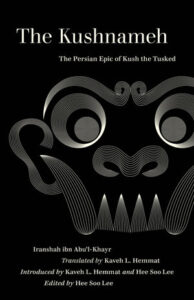
Kaveh Hemmat is Assistant Professor of History, Professional Faculty, in the Department of History, Philosophy, and Theology at Benedictine University. His research focuses on perceptions and representations of East Asia in premodern Islamicate culture.
The great Persian epic known as the Kushnameh follows the entangled lives of Kush the Tusked––a monstrous antihero with tusks and ears like an elephant, descended from the evil emperor Zahhak––and Abtin, the exiled grandson of the last true Persian emperor. Abandoned at birth in the forests of China and raised by Abtin, Kush grows into a powerful and devious warrior. Kush and his foes scheme and wage war across a global stage reaching from Spain and Africa to China and Korea. Between epic battles and magnificent feasts are disturbing, sometimes realistic portrayals of abuse and oppression and philosophical speculation about nature and nurture and the origins of civilization.
What motivated you to work on an English translation of this work, in particular?
The Kushnameh is unusual for medieval Persian literature because it mostly takes place in lands very distant from Iran, including China, Korea, Spain, and North Africa. This is one of the more interesting ways medieval writers adapted the ancient Persian epic tradition to their own era, in which people in Spain could obtain rudimentary knowledge about East Asia from books.
Also, the main character is an anti-hero. Antiheroes loom large in the twenty-first century Anglophone cultural imagination, in TV shows like The Sopranos, Mad Men, and Breaking Bad, and in our politics, with the recent shocking prevalence of performative cruelty and creeping fascism. If history strives to “exorcise the present,” reading about an antihero from a distant era might help us escape the blinders imposed by our own historical moment.
Tell us a little bit about the unique main character of the epic, Kush the Tusked.
He is surely one of the worst main characters in all of ancient and medieval literature. He is evil, both in ways that seem archaic, such as commanding his subjects to worship idols, and in ways that are timelessly horrifying. The way Kush treats his children shocks even Zahhak, who in the larger Iranian epic tradition is the most purely evil of the legendary kings. Kush is also a monstrous sight, with tusks like a boar and ears like an elephant. The epic asks us to think about how and why Kush came to be a monster.
The Kushnameh is a great Persian epic and a fantastical adventure story that’s a riveting read. Can you tell us about one of your favorite scenes from the book?
Iranshah has a knack for dramatic tension — he gets you invested in the characters’ fates, creates a sense of certainty about a situation, and then delivers a sudden twist. So, the epic has a number of excellent battle scenes where, right when you think a character is doomed, they pull a trick out of their hat. I don’t want to spoil those. The other scenes I most enjoy are the ones that construct the epic’s world. In part of the frame story, Alexander the Great is traveling in a remote land and encounters a statue of Kush the Tusked. He is moved because he has come face-to-face with a king as great as himself, but through a veil of time. Learning more about Kush becomes a kind of heroic challenge that involves trying to communicate with horse-headed people, and then leads him to a hermit on a remote mountain top, who tells him about the time of Noah and the legendary Iranian kings, Jamshid and Zahhak.
In this very brief episode we are, in a sense, reading the epic through the eyes of its own characters. Noah, Jamshid, and Zahhak were all quite real to Iranshah’s readers, but also legendary figures. However, we are not learning about them here the way a medieval scholar would, but through the eyes of Alexander, an equally legendary figure. And now I, a most un-legendary person, can see what Alexander traveled to the ends of the earth to find, and be right there with him as he finds it.
What was the translation process like? What factors did you keep in mind as you were translating the work?
I really wanted to convey the drama and the pace of the action. Epics are associated with a certain regal grandiloquence, and while that register may be appropriate for the Persian Epic of Kings (Shahnameh), it misses the mark here. The Kushnameh’s style is simpler than many other Persian epics, and drama and situational irony do more work than word-play. So, I focused on conveying how we should feel about characters and situations, so that readers could develop sympathies and grasp the emotional complexity of some of the complicated situations in the book.
What does The Kushnameh show us about Islamic and Persian cultural history and how does it expand our knowledge of the global middle ages?
First of all, it tells us a lot about what the vast knowledge contained in Arabic and Persian geographies actually meant to the people exposed to it. The Kushnameh shows us that a more expansive knowledge of the world necessitated new ways of reckoning with the past, and how knowledge of East Asia, western Europe, and western Africa played a role in the re-articulation of Persian identity in the later medieval period. The Kushnameh is also an important source for the history of conceptions of race, as it is the people and not only the landscapes of these regions that are depicted, sometimes with very familiar racist tropes. And, fundamentally, if we want to speak of a “Global Middle Ages,” we must read multiple literary traditions and the languages, such as Persian and Arabic, used by the people directly involved in transcontinental trade and travel.
